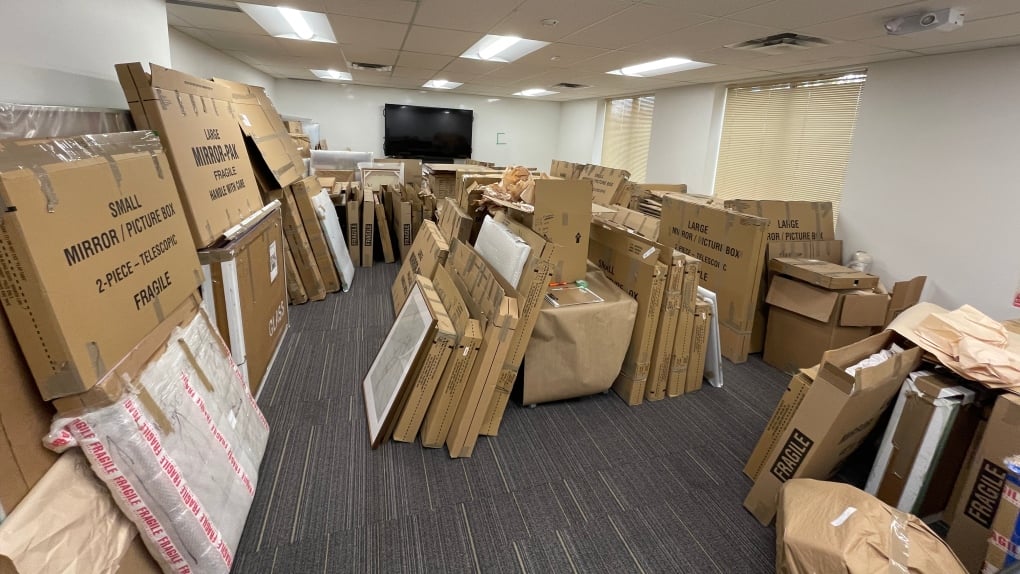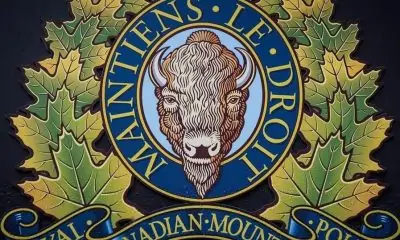If someone said “falcon,” the next word to come to mind probably wouldn’t be “artist.”
Art
An injured kestrel learned to paint and now leads an art class

But Ferrisburgh, an American kestrel with an injured wing, is headlining art classes in Vermont and drawing crowds with his talented talons.
A couple of paintings done by Ferrisburgh are now being auctioned at a fundraiser online, and the raptor recently showed off his skills at the Vermont Institute of Natural Science.
About four years ago, the young male kestrel was brought to the bird rescue at the Vermont Institute of Natural Science in Quechee, Vt., after he was discovered in the nearby town of Ferrisburgh, a place known for its early art colonies, as well as being a stop on the Underground Railroad in the 1800s.
The bird had landed on the shoulder of an unsuspecting person who was out for a walk near his home. The kestrel was loud and chattering away as heperched on the man, and was probably looking to be fed, said Anna Morris, director of on-site and outreach programs at the institute.
“The person who brought him in rightly assumed that this was not normal behavior for a kestrel,” she said.
Morris and her colleagues figured that his willingness to approach humans was because he had been kept illegally in captivity. Vermont law requires a person have a permit, along with proper housing and equipment to keep a falcon.
Employees at the rescue center decided to name the kestrel Ferrisburgh after the town where he was found.
The raptor conducted himself as if he had imprinted on humans as a baby, Morris said, so the bird didn’t know how to behave in the wild, and probably wouldn’t survive there. Workers at the institute thought the kestrel would make an excellent educational flight ambassador.
For several years, Ferrisburgh’s keepers brought him out during field trips and classes so he could fly back and forth and people could get a close-up look at the smallest member of the falcon family.
They also used the little raptor to teach visitors how to help kestrels in the wild by avoiding pesticides and building kestrel nesting boxes to boost population numbers that have declined by about 50 percent since the 1970s.
In June, Ferrisburgh’s role at the bird rescue took a turn when he fractured one of his wings and could no longer fly. Mal Muratori, an environmental educator and family programs director at the institute, found the injured bird on the ground one morning in the kestrel’s enclosure, and said it was unclear how he became hurt.
A veterinarian determined that Ferrisburgh had an old fracture and a new fracture in his right wing, Muratori said, adding that the kestrel had metabolic bone disease probably caused by poor nutrition as a young bird.
“In the wild, 80 percent of Ferrisburgh’s diet would have been insects, supplemented with mice and small birds,” Muratori explained. “But if he was raised in captivity, we have no idea what he might have been fed. His bones were very brittle.”
The kestrel’s keepers wanted to keep him engaged with the public after his injury.
Lexie Smith, an AmeriCorps environmental educator at the institute, had recently watched a friend paint with a crow named Tuck in Tennessee. The crow painted with its beak, using a small sponge that had been dipped into paint. Before coming to the Vermont Institute of Natural Science, Muratori had also watched a crow paint with a brush.
They wondered if Ferrisburgh might also give painting a try as a form of stimulation and exercise.
“I thought it was a cute idea that could also help to educate people about kestrels,” said Smith, 22. “Ferrisburgh could no longer do what he used to do as an ambassador, but maybe he could do art instead.”
She and Muratori said they found an airy space in the building and put down some newspaper and sheets of white paper dabbed with nontoxic blue, teal and pink paint, and then they brought Ferrisburgh out of his enclosure. They used hand signals that he recognized — two fingers tapping on a spot — to get him to run through the paint in exchange for his favorite snack of mealworms.
Soon the bird was running back and forth across the paper, leaving colorful tracks in exchange for treats, Smith said.
She and Muratori saw that Ferrisburgh seemed to enjoy running across paper and canvasses with paint on his talons, so they came up with the idea of having him lead a “Coloring With Kestrels” class.
More than a dozen people paid $10 and showed up for the first class last month, spending an evening coloring pictures with crayons or doing free-form paintings of Ferrisburgh as the raptor created his own artwork at the front of the classroom.
Smith and Muratori placed 14 small white canvases next to each other in a square, then Ferrisburgh walked around through blue, yellow and fuchsia paint. His bright tracks were transferred to the canvas as he scurried around to get his mealworm treats.
“He took to it right away — he was a natural,” Smith said of Ferrisburgh’s class demonstration, which was first reported by USA Today. “Everyone in the class had a lot of fun painting and coloring artworks of Ferrisburgh while he made his own little paintings.”
While Ferrisburgh created his mini action painting, Smith and Muratori gave the class a lesson about kestrels. Another American kestrel, Westford, flew in and went back and forth between the instructors’ thick gloves as they talked about the importance of helping raptors in the wild.
“If you ever find a baby bird outside and you think it needs help, call a wildlife rehabilitator,” said Muratori, 24. “Don’t ever try to raise these birds alone, or they’ll end up like Ferrisburgh. He’s a little bird who think he’s a human.”
As Smith and Muratori figure out if Ferrisburgh is up for leading another class, they are looking into whether some of the institute’s other birds might enjoy making art.
“We’re thinking we’ll try to take up painting with some of them and see what happens,” Smith said, noting that staffers are now training a peregrine falcon named Hawaii to channel his inner artist in the same way as Ferrisburgh.
Instructors had previously tried creating art with one of their Harris’s hawks, but it didn’t work out.
“It was a failure — the hawk loves shredding paper,” Muratori said. “But there are all kinds of art mediums. Maybe we’ll have a poetry event next month and let the birds pick different words.”
Muratori said that could work for Ferrisburgh because he is a vocal and curious bird.
“I think he might also be a natural at that,” Smith added.

Art
Calvin Lucyshyn: Vancouver Island Art Dealer Faces Fraud Charges After Police Seize Millions in Artwork

In a case that has sent shockwaves through the Vancouver Island art community, a local art dealer has been charged with one count of fraud over $5,000. Calvin Lucyshyn, the former operator of the now-closed Winchester Galleries in Oak Bay, faces the charge after police seized hundreds of artworks, valued in the tens of millions of dollars, from various storage sites in the Greater Victoria area.
Alleged Fraud Scheme
Police allege that Lucyshyn had been taking valuable art from members of the public under the guise of appraising or consigning the pieces for sale, only to cut off all communication with the owners. This investigation began in April 2022, when police received a complaint from an individual who had provided four paintings to Lucyshyn, including three works by renowned British Columbia artist Emily Carr, and had not received any updates on their sale.
Further investigation by the Saanich Police Department revealed that this was not an isolated incident. Detectives found other alleged victims who had similar experiences with Winchester Galleries, leading police to execute search warrants at three separate storage locations across Greater Victoria.
Massive Seizure of Artworks
In what has become one of the largest art fraud investigations in recent Canadian history, authorities seized approximately 1,100 pieces of art, including more than 600 pieces from a storage site in Saanich, over 300 in Langford, and more than 100 in Oak Bay. Some of the more valuable pieces, according to police, were estimated to be worth $85,000 each.
Lucyshyn was arrested on April 21, 2022, but was later released from custody. In May 2024, a fraud charge was formally laid against him.
Artwork Returned, but Some Remain Unclaimed
In a statement released on Monday, the Saanich Police Department confirmed that 1,050 of the seized artworks have been returned to their rightful owners. However, several pieces remain unclaimed, and police continue their efforts to track down the owners of these works.
Court Proceedings Ongoing
The criminal charge against Lucyshyn has not yet been tested in court, and he has publicly stated his intention to defend himself against any pending allegations. His next court appearance is scheduled for September 10, 2024.
Impact on the Local Art Community
The news of Lucyshyn’s alleged fraud has deeply affected Vancouver Island’s art community, particularly collectors, galleries, and artists who may have been impacted by the gallery’s operations. With high-value pieces from artists like Emily Carr involved, the case underscores the vulnerabilities that can exist in art transactions.
For many art collectors, the investigation has raised concerns about the potential for fraud in the art world, particularly when it comes to dealing with private galleries and dealers. The seizure of such a vast collection of artworks has also led to questions about the management and oversight of valuable art pieces, as well as the importance of transparency and trust in the industry.
As the case continues to unfold in court, it will likely serve as a cautionary tale for collectors and galleries alike, highlighting the need for due diligence in the sale and appraisal of high-value artworks.
While much of the seized artwork has been returned, the full scale of the alleged fraud is still being unraveled. Lucyshyn’s upcoming court appearances will be closely watched, not only by the legal community but also by the wider art world, as it navigates the fallout from one of Canada’s most significant art fraud cases in recent memory.
Art collectors and individuals who believe they may have been affected by this case are encouraged to contact the Saanich Police Department to inquire about any unclaimed pieces. Additionally, the case serves as a reminder for anyone involved in high-value art transactions to work with reputable dealers and to keep thorough documentation of all transactions.
As with any investment, whether in art or other ventures, it is crucial to be cautious and informed. Art fraud can devastate personal collections and finances, but by taking steps to verify authenticity, provenance, and the reputation of dealers, collectors can help safeguard their valuable pieces.
Art
Ukrainian sells art in Essex while stuck in a warzone – BBC.com
[unable to retrieve full-text content]
Ukrainian sells art in Essex while stuck in a warzone BBC.com

Source link
Art
Somerset House Fire: Courtauld Gallery Reopens, Rest of Landmark Closed
The Courtauld Gallery at Somerset House has reopened its doors to the public after a fire swept through the historic building in central London. While the gallery has resumed operations, the rest of the iconic site remains closed “until further notice.”
On Saturday, approximately 125 firefighters were called to the scene to battle the blaze, which sent smoke billowing across the city. Fortunately, the fire occurred in a part of the building not housing valuable artworks, and no injuries were reported. Authorities are still investigating the cause of the fire.
Despite the disruption, art lovers queued outside the gallery before it reopened at 10:00 BST on Sunday. One visitor expressed his relief, saying, “I was sad to see the fire, but I’m relieved the art is safe.”
The Clark family, visiting London from Washington state, USA, had a unique perspective on the incident. While sightseeing on the London Eye, they watched as firefighters tackled the flames. Paul Clark, accompanied by his wife Jiorgia and their four children, shared their concern for the safety of the artwork inside Somerset House. “It was sad to see,” Mr. Clark told the BBC. As a fan of Vincent Van Gogh, he was particularly relieved to learn that the painter’s famous Self-Portrait with Bandaged Ear had not been affected by the fire.
Blaze in the West Wing
The fire broke out around midday on Saturday in the west wing of Somerset House, a section of the building primarily used for offices and storage. Jonathan Reekie, director of Somerset House Trust, assured the public that “no valuable artefacts or artworks” were located in that part of the building. By Sunday, fire engines were still stationed outside as investigations into the fire’s origin continued.
About Somerset House
Located on the Strand in central London, Somerset House is a prominent arts venue with a rich history dating back to the Georgian era. Built on the site of a former Tudor palace, the complex is known for its iconic courtyard and is home to the Courtauld Gallery. The gallery houses a prestigious collection from the Samuel Courtauld Trust, showcasing masterpieces from the Middle Ages to the 20th century. Among the notable works are pieces by impressionist legends such as Edouard Manet, Claude Monet, Paul Cézanne, and Vincent Van Gogh.
Somerset House regularly hosts cultural exhibitions and public events, including its popular winter ice skating sessions in the courtyard. However, for now, the venue remains partially closed as authorities ensure the safety of the site following the fire.
Art lovers and the Somerset House community can take solace in knowing that the invaluable collection remains unharmed, and the Courtauld Gallery continues to welcome visitors, offering a reprieve amid the disruption.
-

 Sports18 hours ago
Sports18 hours agoLawyer says Chinese doping case handled ‘reasonably’ but calls WADA’s lack of action “curious”
-

 Sports3 hours ago
Sports3 hours agoDolphins will bring in another quarterback, while Tagovailoa deals with concussion
-

 News17 hours ago
News17 hours agoB.C. to scrap consumer carbon tax if federal government drops legal requirement: Eby
-

 News18 hours ago
News18 hours agoRCMP say 3 dead, suspects at large in targeted attack at home in Lloydminster, Sask.
-

 Sports4 hours ago
Sports4 hours agoDavid Beckham among soccer dignitaries attending ex-England coach Sven-Goran Eriksson’s funeral
-

 News18 hours ago
News18 hours agoCeiling high for Vancouver Whitecaps midfielder Ahmed: Canada coach
-

 News17 hours ago
News17 hours agoA linebacker at West Virginia State is fatally shot on the eve of a game against his old school
-

 News18 hours ago
News18 hours agoShapovalov, Auger-Aliassime lift Canada over Finland 3-0 in Davis Cup tie





















